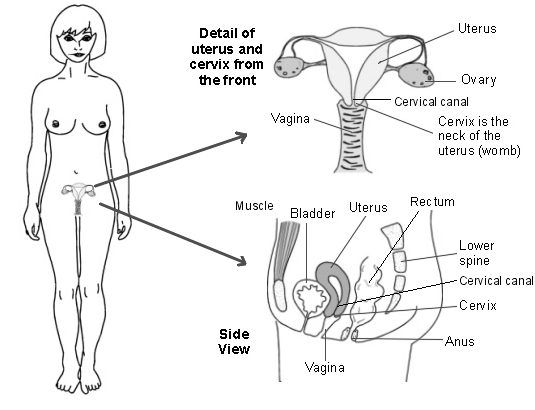What is the cervix?
The cervix is the lower part of the uterus (womb) which extends slightly into the top of the vagina. The cervix is often called 'the neck of the womb'.
A narrow passage called the cervical canal (or endocervical canal) goes from the vagina to the inside of the uterus. This is normally kept quite tightly shut, but allows blood to flow out from the uterus during a period, and sperm to travel inside if you have sex. (It opens very wide during labour if you have a baby.)
The surface of the cervix is covered with skin-like cells. There are also some tiny glands in the lining of cervical canal which make mucus.

What is cancer?
Cancer is a disease of the cells in the body. The body is made up from millions of tiny cells. There are many different types of cell in the body, and there are many different types of cancer which arise from different types of cell. What all types of cancer have in common is that the cancer cells are abnormal and multiply 'out of control'.
A malignant tumour is a 'lump' or 'growth' of tissue made up from cancer cells which continue to multiply. Malignant tumours invade into nearby tissues and organs which can cause damage.
Malignant tumours may also spread to other parts of the body. This happens if some cells break off from the first (primary) tumour and are carried in the bloodstream or lymph channels to other parts of the body. These small groups of cells may then multiply to form 'secondary' tumours (metastases) in one or more parts of the body. These secondary tumours may then grow, invade and damage nearby tissues, and spread again.
Some cancers are more serious than others, some are more easily treated than others (particularly if diagnosed at an early stage), some have a better outlook (prognosis) than others.
So, cancer is not just one condition. In each case it is important to know exactly what type of cancer has developed, how large it has become, and whether it has spread. This will enable you to get reliable information on treatment options and outlook. See separate leaflet called 'What are Cancer and Tumours' for further details about cancer in general.
What is cervical cancer?
There are two main types of cervical cancer.
Both types are diagnosed and treated in a similar way. Most cases develop in women in their 30s or 40s although some cases develop in older and younger women.
About 4000 new cases of cervical cancer are diagnosed each year in the UK. However, it is a cancer that can be prevented by regular cervical smear tests which aims to detect cervical dysplasia.
What is cervical dysplasia?
Cervical dysplasia is not cervical cancer. Cervical dysplasia means that some cells of the cervix are abnormal (dysplastic), but are not cancerous. They are sometimes called 'pre-cancerous'. However, dysplastic cells at some point may become even more abnormal, and turn cancerous.
Dysplastic cells are detected by cervical smear tests. Briefly, women in the UK are offered a smear test every three years. Some cells are scrapped off the surface of the cervix. These are 'smeared' onto a glass slide and are sent to the lab to be looked at under the microscope. In most smear tests the cells seen are normal, but dysplastic cells are seen in some cases.
Dysplastic cells are classed into three grades of severity
If you have just mildly abnormal changes, you may simply be offered more regular smear tests. In many cases, mildly abnormal cells revert back to normal. For women with more severe abnormal changes, treatment can clear the cervix of the abnormal cells before they develop into cancer.
See separate leaflet called 'Cervical Smear Test' for more details. But the 'take-home message' is: if you have regular smear tests, at the times advised by your doctor, and treatment when advised if abnormal cells are detected, you are very unlikely to develop cervical cancer.
What causes cervical cancer?
A cancerous tumour starts from one abnormal cell. The exact reason why a cell becomes cancerous is unclear. It is thought that something damages or alters certain genes in the cell. This makes the cell abnormal and multiply 'out of control'. (See separate leaflet called 'What Causes Cancer' for more details.)
In the case of cervical cancer, the cancer develops from a cell which is already partly abnormal (dysplastic) - see above. In most cases, dysplastic cells are present for years before one cell becomes cancerous and starts to multiply out of control into a cancerous tumour.
There are 'risk factors' which are known to increase the risk of cervical cancer developing. These include the following.